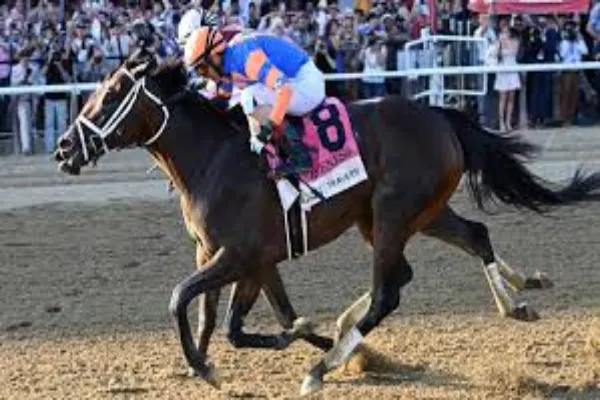Key Prep Race Performances That Could Influence the 2025 Travers Stakes Field

The Travers Stakes returns on August 23, 2025, with Saratoga’s dirt stretching a true 1¼ miles. That distance, fixed since 1904, asks for speed that lasts and minds that settle late. The purse sits at $1.25 million, adding pressure to every summer decision that points here.
Fans call Saratoga the “Graveyard of Favorites,” a nickname earned by high-profile upsets. Recent history supports the caution, yet class still rises when it travels the right way.
This article looks at prep performances that tend to hold up over 10 furlongs. We will weigh distance clues, speed figures, human factors, and Triple Crown form, highlighting the lines that usually transfer from spring and summer into Saratoga’s Midsummer Derby.
Belmont at Saratoga: A Live Rehearsal for 1¼ Miles
The most obvious preparatory marker is recent success at, or near, the Travers distance. In 2024, the Belmont ran at Saratoga over 1¼ miles because of downstate renovations. That placed a premier stamina test on the very track that will host August’s centerpiece.
Dornoch’s Belmont victory therefore reads like a rehearsal, matching distance and surface demands exactly. Performances like that reduce guesswork about stretching out and handling Saratoga’s dirt. Horses untested beyond 1⅛ miles can still improve, but the final furlongs often expose limits.
When evaluating contenders, treat proven 10-furlong ability as a premium trait. The Travers routinely rewards that combination of efficiency and staying power under pressure. Recent evidence suggests it remains the cleanest line in the formbook.
Speed Figures: Reading 110s With Context
High recent speed figures flag raw ability, yet Saratoga’s race shape can punish single-gear speed. Fierceness posted Equibase marks of 110 and 108 in major preps, illustrating the top-end talent required.
Numbers like those matter, but context matters as much as the figure itself. Travers fields often feature multiple pace-pressing types that crank the early tempo. Horses forced to duel early may empty before the stretch, despite dazzling prior ratings.
Look for runners who can earn big numbers while rating kindly or finishing strongly. Versatility improves the probability that strong figures will repeat against different flows. A pace-agile style helps a contender translate previous peaks into this longer test.
When assessing preps, prefer efforts showing patience, positioning, and late energy. Those patterns tend to survive Saratoga’s searching stretch.
The Favorite Paradox: Preps That Expose Vulnerability
Recent Travers results advise balance when dealing with market leaders. Only three favorites won in the last decade:
- Tiz the Law in 2020,
- Essential Quality in 2021,
- Epicenter in 2022.
Historically, favorites capture about 44%, which underscores respect with a side of caution. Preps that flatter loose leaders can overstate reliability at ten furlongs.
Conversely, closing efforts masked by unfavorable setups often become live at Saratoga. Hunt for races where a contender overcame traffic, pressure, or an unhelpful pace landscape. Those lines suggest resilience when conditions toughen and riders time their runs later.
For more insights on market trends and contender form, check the latest Travers Stakes picks. The Travers rarely grants easy trips, so it requires prep evidence that handles adversity and distance together.
Trainer and Jockey Signals From Summer Preps
Patterns from barns and riders often carry from preps into Saratoga’s August showpiece. Bert Mulholland owns the training record with five victories, a historical marker worth noting. Bob Baffert stands alone with multiple Travers wins in the last decade, signaling recurring summer targeting.
On the riding side, Javier Castellano leads with seven wins, including four since 2014. Jockeys like Mike Smith and Luis Saez have also excelled on this stage.
Use preps to read intent, especially when elite connections pilot schooling trips at longer routes. A patient ride into a strong finish can telegraph the August plan more than raw time.
Similar signals appear when a barn spaces starts to build stamina rather than speed. Trust proven Travers operators when prep placement mirrors past success. Experience converting intention into execution often decides tight finishes.
Triple Crown Formlines and Eclipse Ambitions
Class usually leaves footprints before Saratoga, often on the Triple Crown trail. Many Travers winners already owned top-level results or were chasing awards with substance.
Since 1972, 35 Travers runners have been later named champion 3-year-old, with 15 becoming Horse of the Year. Those counts reinforce the link between spring excellence and midsummer authority. When scouting preps, elevate horses with graded wins or strong placings in the Derby, Preakness, or Belmont.
That opposition level clarifies ability against the best of the generation. The Travers often functions as a season’s reckoning among elite sophomores. Eclipse momentum, even if unfinished, can push connections to prime this date. Read prep choices through that lens: class contends when conditioning matches ambition. Saratoga then becomes the courtroom where reputations either advance or stall.
Distance Progressions: From 1⅛ Miles to a True 10 Furlongs
Route form at 1⅛ miles offers clues, but the Travers adds another demanding furlong. Horses proven at or near the target distance historically hold an advantage.
Many summer preps stop at 9 furlongs, which can mask late-stretch limitations. Watch how a prospect finishes and whether energy distribution remains efficient past the mile. Runners stepping up for the first time may struggle through Saratoga’s testing final yards.
Preps that feature sustained finishing runs, rather than brief bursts, translate better at 10 furlongs. Conversely, fading late despite a comfortable trip warns against stretching to the Travers distance.
The goal is simple: find evidence that stamina complements speed under real pressure. Performances that marry staying power and composure usually survive the extra ground. Those are the profiles that stay on when the wire looms.
A Betting Checklist for August 23rd
The race offers $1.25 million and history, but it rewards balance over flash. Keep that frame while summer unfolds, and the field will make more sense. On Travers Day, this checklist should reflect preparation that mirrors the test itself:
- From now through August, weigh prep lines against Saratoga’s known demands,
- Prioritize recent success at 1¼ miles, especially efforts matching surface and venue,
- Upgrade big figures earned with rating ability or credible finishing strength,
- Treat favorites with caution unless preps show versatility against heat and traffic,
- Track signals from proven Travers operators, including riders with deep histories here,
- Consider Triple Crown form lines and whether connections still chase Eclipse relevance,
- Study stretch energy in 1⅛-mile preps for stamina that scales up.
Final Furlong: Turning Prep Clues Into Travers Picks
The Travers Stakes is rarely won on raw speed alone. Success comes from combining proven stamina, tactical adaptability, and the class to withstand Saratoga’s demanding stage.
By focusing on preps that mirror the 10-furlong test, reading the intent of top connections, and weighing both speed and substance, bettors can separate fleeting form from lasting talent.
Come August 23rd, the horse that has shown it can stay, adjust, and finish under pressure will be the one most likely to etch its name into Midsummer Derby history.






